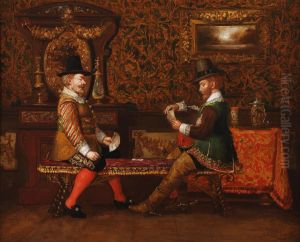H. Francken Paintings
H. Francken, known more fully as Hieronymus Francken I, was a prominent figure in the Francken family, a dynasty of artists that played a significant role in the development of Flemish art during the 16th and 17th centuries. Born in 1540 in Herentals, near Antwerp, he was part of a lineage that included several notable painters, such as his brother Frans Francken I and his nephews Frans Francken II and Ambrosius Francken I, who were instrumental in the transition from Mannerism to Baroque within the Flemish tradition. Hieronymus Francken I himself was a key figure in this artistic evolution, particularly known for his contributions to the genres of history painting and portraiture.
Educated in the rich cultural atmosphere of Antwerp, then one of the leading art centers of Europe, Hieronymus was deeply influenced by the Italian Renaissance, integrating its styles and techniques into the northern European tradition. His works often depicted religious and mythological scenes, characterized by their precise composition, attention to detail, and vibrant use of color. Francken spent a significant part of his career in France, where he worked at the court of Henry III, contributing to the spread of Flemish artistic styles across Europe.
Despite the overshadowing fame of his relatives in later generations, Hieronymus Francken I's contribution to the art world was substantial. His ability to blend the intricate detail typical of Flemish painting with the grandeur and spatial complexity of Italian Renaissance art made his work distinctive. After his return to Antwerp, he became a master in the city's Guild of St. Luke, indicating his recognition and status within the artistic community.
Hieronymus Francken I passed away in 1610, leaving behind a legacy that would be carried forward by his family and the many pupils who emerged from the Francken workshop. Although specific details about his life and the full extent of his oeuvre remain partially obscured by time, his influence on the development of Flemish painting is undisputed. His works continue to be studied and admired for their contribution to the transition period that shaped the course of Western art history.
